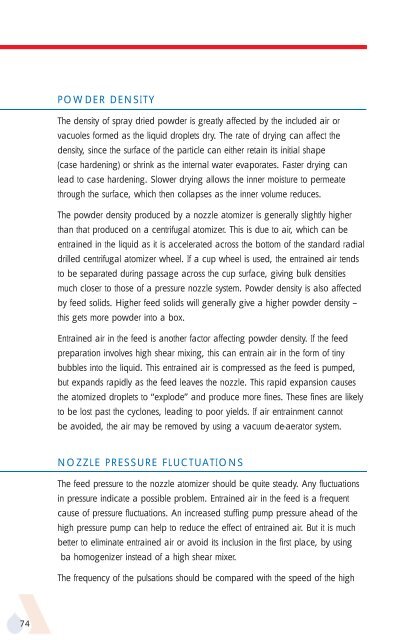APV Dryer Handbook - Umbc
APV Dryer Handbook - Umbc
APV Dryer Handbook - Umbc
You also want an ePaper? Increase the reach of your titles
YUMPU automatically turns print PDFs into web optimized ePapers that Google loves.
74<br />
POWDER DENSITY<br />
The density of spray dried powder is greatly affected by the included air or<br />
vacuoles formed as the liquid droplets dry. The rate of drying can affect the<br />
density, since the surface of the particle can either retain its initial shape<br />
(case hardening) or shrink as the internal water evaporates. Faster drying can<br />
lead to case hardening. Slower drying allows the inner moisture to permeate<br />
through the surface, which then collapses as the inner volume reduces.<br />
The powder density produced by a nozzle atomizer is generally slightly higher<br />
than that produced on a centrifugal atomizer. This is due to air, which can be<br />
entrained in the liquid as it is accelerated across the bottom of the standard radial<br />
drilled centrifugal atomizer wheel. If a cup wheel is used, the entrained air tends<br />
to be separated during passage across the cup surface, giving bulk densities<br />
much closer to those of a pressure nozzle system. Powder density is also affected<br />
by feed solids. Higher feed solids will generally give a higher powder density –<br />
this gets more powder into a box.<br />
Entrained air in the feed is another factor affecting powder density. If the feed<br />
preparation involves high shear mixing, this can entrain air in the form of tiny<br />
bubbles into the liquid. This entrained air is compressed as the feed is pumped,<br />
but expands rapidly as the feed leaves the nozzle. This rapid expansion causes<br />
the atomized droplets to “explode” and produce more fines. These fines are likely<br />
to be lost past the cyclones, leading to poor yields. If air entrainment cannot<br />
be avoided, the air may be removed by using a vacuum de-aerator system.<br />
NOZZLE PRESSURE FLUCTUATIONS<br />
The feed pressure to the nozzle atomizer should be quite steady. Any fluctuations<br />
in pressure indicate a possible problem. Entrained air in the feed is a frequent<br />
cause of pressure fluctuations. An increased stuffing pump pressure ahead of the<br />
high pressure pump can help to reduce the effect of entrained air. But it is much<br />
better to eliminate entrained air or avoid its inclusion in the first place, by using<br />
ba homogenizer instead of a high shear mixer.<br />
The frequency of the pulsations should be compared with the speed of the high











